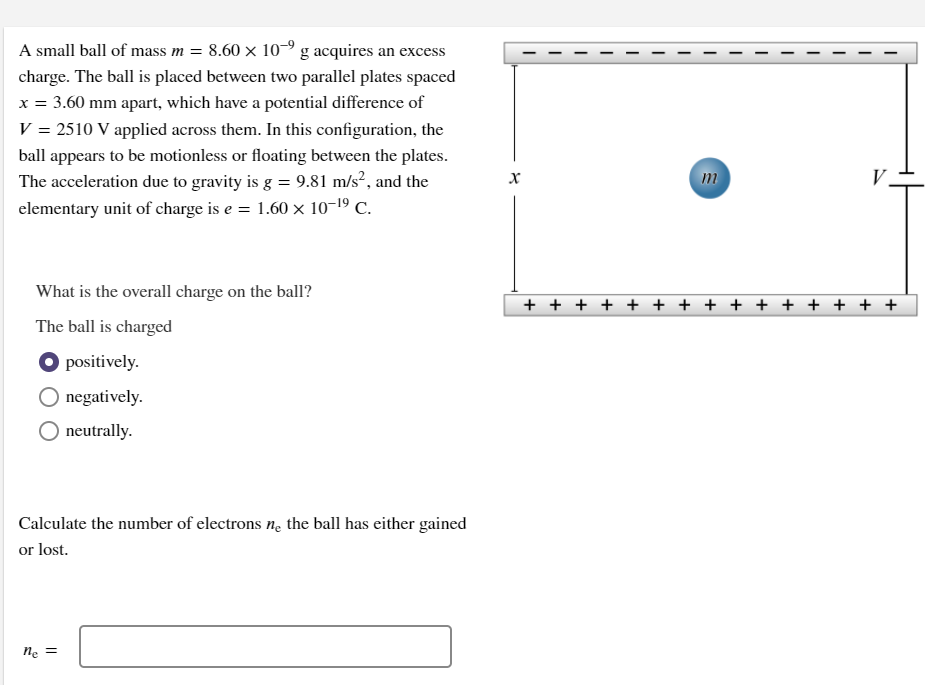A small ball of mass m = 8.60 × 10-º g acquires an excess charge. The ball is placed between two parallel plates spaced x = 3.60 mm apart, which have a potential difference of V = 2510 V applied across them. In this configuration, the ball appears to be motionless or floating between the plates. The acceleration due to gravity is g = 9.81 m/s², and the elementary unit of charge is e = 1.60 × 10-19 c. V. What is the overall charge on the ball? + + + + + + + + + + + + + + + The ball is charged O positively. O negatively. O neutrally. Calculate the number of electrons n, the ball has either gained or lost. ne =
A small ball of mass m = 8.60 × 10-º g acquires an excess charge. The ball is placed between two parallel plates spaced x = 3.60 mm apart, which have a potential difference of V = 2510 V applied across them. In this configuration, the ball appears to be motionless or floating between the plates. The acceleration due to gravity is g = 9.81 m/s², and the elementary unit of charge is e = 1.60 × 10-19 c. V. What is the overall charge on the ball? + + + + + + + + + + + + + + + The ball is charged O positively. O negatively. O neutrally. Calculate the number of electrons n, the ball has either gained or lost. ne =
Chapter7: Electric Potential
Section: Chapter Questions
Problem 77P: An election enters a region between two large parallel plates made of aluminum separated by a...
Related questions
Question
How to solve this question

Transcribed Image Text:A small ball of mass m = 8.60 × 10-º g acquires an excess
charge. The ball is placed between two parallel plates spaced
x = 3.60 mm apart, which have a potential difference of
V = 2510 V applied across them. In this configuration, the
ball appears to be motionless or floating between the plates.
The acceleration due to gravity is g = 9.81 m/s², and the
elementary unit of charge is e = 1.60 × 10-19 c.
V.
What is the overall charge on the ball?
+ + + + + + + + + + + + + + +
The ball is charged
O positively.
O negatively.
O neutrally.
Calculate the number of electrons n, the ball has either gained
or lost.
ne =
Expert Solution
This question has been solved!
Explore an expertly crafted, step-by-step solution for a thorough understanding of key concepts.
This is a popular solution!
Trending now
This is a popular solution!
Step by step
Solved in 2 steps with 2 images

Recommended textbooks for you


College Physics
Physics
ISBN:
9781305952300
Author:
Raymond A. Serway, Chris Vuille
Publisher:
Cengage Learning

Physics for Scientists and Engineers: Foundations…
Physics
ISBN:
9781133939146
Author:
Katz, Debora M.
Publisher:
Cengage Learning


College Physics
Physics
ISBN:
9781305952300
Author:
Raymond A. Serway, Chris Vuille
Publisher:
Cengage Learning

Physics for Scientists and Engineers: Foundations…
Physics
ISBN:
9781133939146
Author:
Katz, Debora M.
Publisher:
Cengage Learning

College Physics
Physics
ISBN:
9781285737027
Author:
Raymond A. Serway, Chris Vuille
Publisher:
Cengage Learning

Principles of Physics: A Calculus-Based Text
Physics
ISBN:
9781133104261
Author:
Raymond A. Serway, John W. Jewett
Publisher:
Cengage Learning